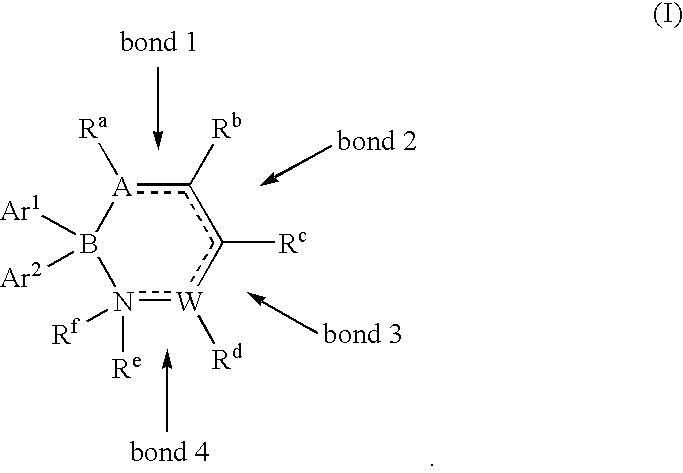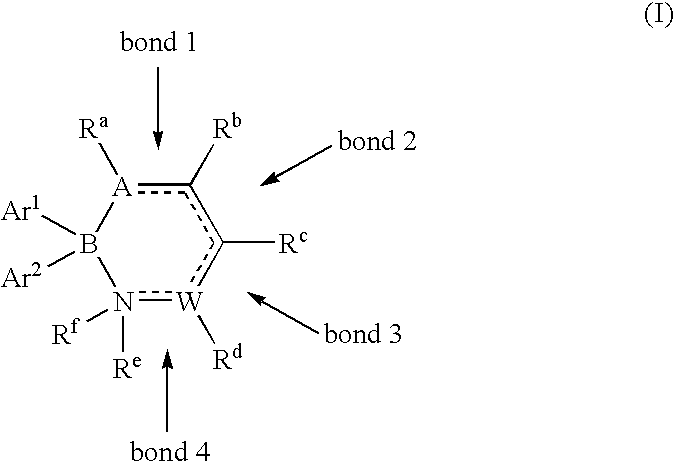Methods for the preparation of alkyl diaryl borinates and complexed diarylboronic acids
- Summary
- Abstract
- Description
- Claims
- Application Information
AI Technical Summary
Benefits of technology
Problems solved by technology
Method used
Image
Examples
example 1
General Procedure for the Synthesis of Methyl Diarylborinates
Trimethylborate (0.95 eq) is added dropwise to a freshly prepared solution of aryl magnesium bromide (2 eq) in tetrahydrofuran (0.3 M) under argon at −78° C. The mixture is warmed to room temperature and stirred overnight. The solution is cooled to −78° C. and excess Grignard reagent is destroyed by the dropwise addition of methanol until no more effervescence is observed. Solvents are removed in vacuo and the residue dissolved in diethyl ether followed by a water wash. The organic layer is dried (over MgSO4), filtered and the solvents removed in vacuo to give the product as a foam that can be used without further purification. Any trialkylborate may be used as a substitute for trimethylborate including triethylborate and tributylborate, as discussed above.
example 2
General Procedure for the Synthesis of N—O Complexed Diarylboronic Acids
The complexing agent (0.9 eq) is dissolved in methanol (or dichloromethane depending on solubility) and added to a solution of methyl diarylborinate (1 eq) (prepared as outlined above) in methanol. The solution is allowed to stand overnight, if the product has crystallized, the solid is collected and washed with cold ethanol; otherwise the solvents are removed in vacuo to give a solid which is purified by recrystallization from ethanol or diethyl ether (depending on the complexing agent). If this is unsuccessful the product is purified by column chromatography on silica gel eluting with diethyl ether / hexane.
example 3
Synthesis of Methyl Di(p-chlorophenyl)borinate
Trimethylborate (2.2 ml, 1.92×10−2 mol) is added dropwise to a freshly prepared solution of p-chlorophenyl magnesium bromide (40.4 ml, 1 M, 4.04×10−2 mol) in tetrahydrofuran (60 ml) under argon at −78° C. The mixture is warmed to room temperature and stirred overnight. The solution is cooled to −78° C. and excess grignard reagent is destroyed by the dropwise addition of methanol until no more effervescence is observed. The solvents are removed in vacuo and the residue dissolved in diethyl ether and washed with water. The organic layer is dried (MgSO4), filtered and the solvents removed in vacuo to give methyl di(p-chlorophenyl)borinate (4.60 g, 92%) as a solid which was used without further purification.
PUM
 Login to View More
Login to View More Abstract
Description
Claims
Application Information
 Login to View More
Login to View More - R&D
- Intellectual Property
- Life Sciences
- Materials
- Tech Scout
- Unparalleled Data Quality
- Higher Quality Content
- 60% Fewer Hallucinations
Browse by: Latest US Patents, China's latest patents, Technical Efficacy Thesaurus, Application Domain, Technology Topic, Popular Technical Reports.
© 2025 PatSnap. All rights reserved.Legal|Privacy policy|Modern Slavery Act Transparency Statement|Sitemap|About US| Contact US: help@patsnap.com



